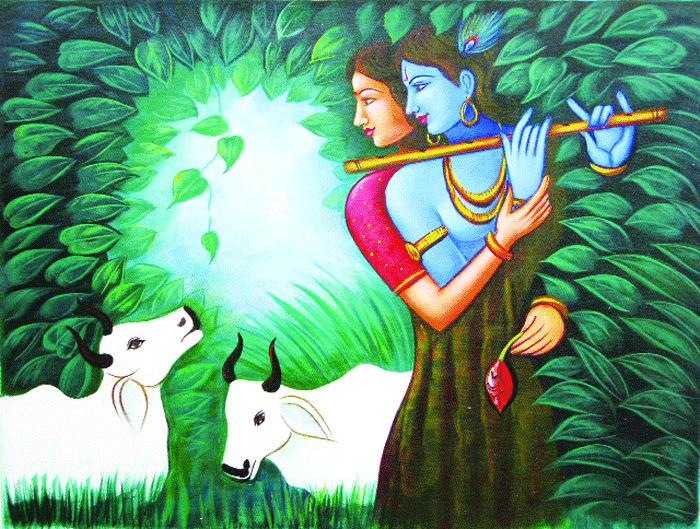legend has it that she was born from one part of Krishna’s body, says Asha Goswami
Radha is chief among the gopis who were the associates of Krishna during his Vrindavan lilas. She has a pivotal role in Krishna cult, which is incomplete without her. So much so that it is evident from the belief current among the masses that if one could not achieve the desired goal through great tapas and meditation in Satyayuga, now in Kaliyuga can achieve by merely chanting the name of Shri Radha.
Old sources on Krishna are, however, silent about her. Still, in later Puranas, she is mentioned as an unnamedgopi who may be known as the urform of the Radha concept. But in the Brahmavaivarta Purana, Krishna as infant is referred to have been married to
14-year-old Radha through Gandharva marriage which was conducted by God Brahma himself. The same work also adds the geneology of Radha and she is said to arise from the left part of Shri Krishna’s body and that half portion turned into Radha. The same work also refers to Radha’s husband as Rayana Gopa.
Such elaborate Radha legends as intermixed with Krishna concept are suggestive of her special status as a mystic personae and are indicative of the fact about an unnamedgopi of the earlier stages in Krishna saga subsequently turning into his wedded wife to promulgate the cult of Radha-Krishna amatory — apart from being presented as an unmarried gopi, who as a devotee had intensive love for Krishna just like the human soul’s quest for the God.
Besides, the legendary account of Radha also suggests her as a dynamic symbol when she is stated as being born from one part of Krishna’s body. Her image occupying left side of Krishna, the Supreme in the temples represent her as static symbol, as it suggests her to be the corresponding feminine power of the lord that enables him to perform his lilas just like other Gods Purusha Purushottama, Shiva are helped by her assuming the form of Prakriti, Saraswati and Shakti or Parvati. This makes it abundantly clear that the Radha myths and legends, which are associated with Krishna in the later sources, have hidden mystical and symbolic implications and be taken in the same spirit.
Radha is held to represent the advanced stage of the Gopi concept, which signifies the individual souls that had immersed themselves in the supreme soul titled as Krishna. The Vaishnavas, however, deem her as an embodiment of Krishna himself; his inherent nature, his very soul, and his 16th kala.
InPadmapurana, Radha is referred to as the primeval energy (adishakti) and thus the cause of the entire creation including the trio deities Brahma,Vishnu, and Mahesha-shiva. Constituting Krishna’s blissful aspect as he is known as raso vai sah, she is also called by other names like Aahladini Shivashakti, Paraaprakriti, lakshmi and Mahamaya, and thus represents his divine energy which serves the very source of the whole world. Thus, she turns to be identical with the Goddesses Saraswati, Durga, Kali, and Parvati. According to Ramanuja, Krishna and Radha represent the duo purusha prakriti of the Samkhya philosophy. Her cult is included amongst the cultic practices of Vallabha’s pushti saadhanaa.
While according to Shri Chaitanya, the Radhabhaava represents “best of devotee’s love for God”. The origin of the concept ofRadha can be traced back to theRigveda wherein the vedic God Indra is invoked as Radhapati to grantradhas denoting wealth and food to his devotees. This trait of Indra was first passed on to another vedic God Vishnu and next to Krishna, his complete avatara, who like God Vishnu had to be conceptualised as Radhapati.
later, when the doctrine of emotional devotion (raagunnugaa bhakti) appeared on the cultural scene of Indian life, the object of bhakti — who was in earlier times lakshmipati Vishnu — turned into Radhapati Krishna, and Radha, earlier as Shrishakti constituting the vital life force of Krishna worship, was now allotted another role — that of a worshipper of Krishna apart from being his intrinsic divine power.
She also stands for the developed form of Goddess lakshmi, the ideal wife of God Vishnu. later, due to the amalgamation of the Pancharatra cult with Krishnaism, Radha is assigned with amorous element and is known as Kamala and Mohini. Thus, endowed with a tantric touch, Shri Radha gave up her former motherly effect and turned into a charming beautiful personae symbolising the goddess of beauty who not only represents an embodiment of pure emotional loving attitude of a worshipper and a culmination of the spirit and soul of devotion, but also of lord’s greatest attribute of bliss and his intrinsic selfhood, who as Mahamaya Prakriti takes up the role of an interceder to wake up Krishna to function properly in the cause of creation, perseverance and destruction.
Moreover, the mystical import of Radha concept is suggestive of the realisation of oneness with the almighty Krishna through para bhakti represented by Shri Radha, the devotee par excellence, as none other than her could perform best type of aradhana, as goes the maxim “aaraadhayati raadhayati iti saa”.
Thus, these revelations on the notion of Radha in Krishna lore suggest her to be the bestower of Krishna devotion and the nearness to his feet; and also bring her near the concept of Durga personifying the eternal prakriti, who like her is equally the conferrer of good fortune, plenty of food and wealth. Hence, let us offer our obeisance to the same power personifying Goddess Durga: “Yaa devi sarvabhuteshu Vishnu mayeti shabditaa, namastasyai namastasyai namastasyai namo namah.”
The writer is noted Indologist and authority on Krishnaite Studies


























